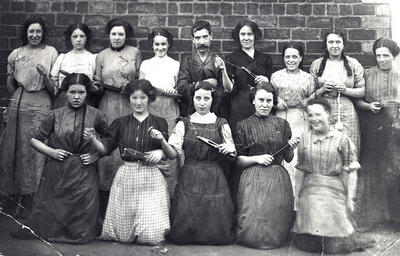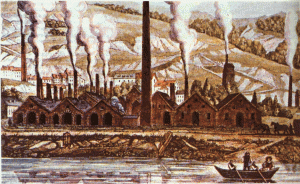“The weaver and the factory maid” è una canzone tradizionale sui tessitori, proveniente da Glasgow
“The weaver and the factory maid” è una canzone tradizionale sui tessitori, proveniente da Glasgow; il tono è amaro e rassegnato, il nostro tessitore si lamenta di non essere più ambito dalle ragazze (a causa della sua dequalificazione professionale), che anzi hanno trovato il lavoro in fabbrica (opificio tessile) e lo snobbano!
Vorrebbe andare anche lui in fabbrica, pur di trovarsi una brava ragazza e mettere su famiglia.
[ Roud 17771 , 3085 ; Ballad Index DTwvfact ; VWML CJS1/10/1/34/1 ; Bodleian Roud 17771 ; EBBA 21142 ; Mudcat 24012 , 139263 ; trad.]
The weaver and the factory maid
I
I’m a hand weaver to my trade.
Long time I courted a factory maid,
And if I could her kind favour win,
I’d stand beside her and I’d weave by steam.
II
It’s many’s the year now, I’ve plied my skill,
By my own fireside long before the mill,
I wove fine linen and silk so fair
While the pitching shuttle sings my lassie’s name.
III
My father’s often unto me said,
“How could you fancy a factory maid?
When you could have women of grace and style Who’d like to win the master weaver’s smile.”
IV
But the weaver’s fortune of my father’s age,
Has faded now to a meagre wage
And the darkened factories of Anderstown(1),
Have brought the prices and the weavers down.
V
Where are the lassies now I’ll tell you plain
The girls have all gone to weave by steam,
And if you would find them you must rise at dawn
And trudge to the mill in the early morn.
traduzione italiana di Cattia Salto
I.
Sono un artigiano tessitore
da tanto corteggiavo un’operaia
e se riuscirò a ottenere i suoi favori,
le starei accanto e tesserei al telaio a vapore.
II.
Sono molti anni ora che ho fatto pratica
accanto al focolare, molto prima della fabbrica,
tessevo lino fine e seta così bella,
mentre la spoletta cantava il nome della mia ragazza
III.
Mio padre spesso mi diceva
“Come puoi innamorarti di un’operaia,
quando puoi avere donne graziose,
che vorrebbero strappare il sorriso al maestro tessitore?”
IV.
Ma la ricchezza del tessitore del tempo di mio padre
è svanita ora in un misero salario,
e le sporche fabbriche di Anderstown
hanno portato prezzi e tessitori in ribasso.
V.
Dove sono ora le ragazze te lo dico chiaro:
le ragazze sono andate a tessere al telaio a vapore
e per trovarle devi alzarti all’alba,
e arrancare verso la fabbrica di mattino presto
NOTE
(1) Anderston è un quartiere di Glasgow

LA VERSIONE EROTICA (A.L. Lloyd – Steeleye Span)
Un’altra versione testuale di “The weaver and the factory maid” è stata arrangiata da A.L. Lloyd e ripresa dagli Steeleye Span che hanno aggiunto come prima strofa i versi ripresi da Robert Cinnamond. La melodia è la stessa di “The Weaver and the Chambermaid“, ballata dalla quale proviene anche parte del testo parzialmente modificato di modo che la “chamber maid” diventa una “factory maid”.
La ballata di genere erotico risale al 1600 contenuta in un broadside dal titolo “Will the Weaver, and Charity the Chambermaid”. Nella raccolta “Working Songs” (2010) di Roy Palmer si fa risalire testo e musica al 1839 mentre A.L. Lloyd avrebbe raccolto il brano da William Oliver di Widnes nel 1951.
Qui il tessitore si lascia andare ad un sogno erotico e anche le immagini si mescolano trascendendo nel pecoreccio.
I (1)
When I was a tailor
I carried my bodkin and shears;
When I was a weaver
I carried my rood (2) and my gear(3).
My temples(4) also, my small clothes
and reed(5) in my hand,
And wherever I go, “Here’s the jolly bold weaver again.”
II
I’m a hand weaver to my trade
I fell in love with a factory maid
And if I could but her favour win
I’d stand beside her and weave by steam
III
My father to me scornful said
“How could you fancy a factory maid
When you could have girls fine and gay
Dressed like unto the Queen of May”
IV
“As for your fine girls I don’t care
If I could but enjoy my dear
I’d stand in the factory all the day
And she and I’d keep our shuttles in play(6)”
V
I went to my love’s bedroom door
Where often times I had been before
But I could not speak nor yet get in
The pleasant bed that my love laid in
VI
“How can you say it’s a pleasant bed
Where naught lies there but a factory maid?”
A factory lass although she be
Blessed is the man that enjoys she
VII
O pleasant thoughts come to my mind
As I turn down the sheets so fine
And I seen her two breasts standing so
Like two white hills all covered with snow
VIII (7)
The loom goes click and the loom goes clack
The shuttle flies forward and then flies back
The weaver’s so bent that he’s like to crack
Such a wearisome trade is the weaver’s.
IX
The yarn is made into cloth at last
The ends of weft they are made quite fast
The weaver’s labour are now all past
Such a wearisome trade is the weaver’s.
X
Where are the girls I will tell you plain
The girls have gone to weave by steam
And if you’d find them you must rise at dawn
And trudge to the mill in the early morn.
traduzione italiana di Cattia Salto
I
Quando ero un sarto
portavo il mio ago e le forbici;
quando ero un tessitore
portavo il mio crocefisso (2) e il liccio(3)
e anche il mio tempiale(4)
e le mie stoffe e il pettine(5) in mano
e andavo dicendo “Ecco il vostro bravo tessitore.”
II
Sono un tessitore artigianale, è il mio mestiere,
mi sono innamorato di un’operaia,
e se riuscissi a ottenere i suoi favori
le starei accanto e tesserei al telaio a vapore
III
Mio padre mi diceva sprezzante
“Come puoi innamorarti di un’operaia,
quando puoi avere belle donne e allegre
vestite come la Regina di Maggio?”
IV
“Delle tue belle non m’importa,
se potessi divertirmi con la mia cara,
starei in fabbrica tutto il giorno
e lei ed io metteremo le nostre navette al lavoro”(6)
V
Andavo alla porta del mio amore,
come spesso avevo fatto prima,
ma non potevo parlare e nemmeno entrare
nel bel letto dove stava il mio amore.
VI
“Come puoi dire che è un bel letto dove ci si sdraia
nient’altro che una ragazza della fabbrica?”
“Foss’anche un’operaia
beato è l’uomo che ne gode i favori!”
VII
Dilettevoli pensieri mi vengono in mente,
mentre mi rivolto nelle belle lenzuola,
e mi immaginavo i suoi seni belli dritti,
come due colline bianche tutte coperte di neve
VIII
Il telaio fa click e fa clack (7)
la navetta vola in avanti e poi torna indietro
il tessitore è così piegato che sembra stia per spezzarsi,
un affare faticoso è il lavoro del tessitore.
IX
Il filato è trasformato in stoffa alla fine,
sono giunti velocemente alla fine della trama
il lavoro del tessitore ora è finito
un affare faticoso è il lavoro del tessitore.
X
Dove sono le ragazze te lo dico chiaro:
le ragazze sono andate a tessere al telaio a vapore
e per trovarle devi alzarti all’alba,
e arrancare verso la fabbrica al mattino presto
NOTE
(1) Robert Cinnamond “The Weave” collezionata da Sean O’Boyle contea di Antrim nel 1955. I versi fanno:
When I was a tailor, I carried my bodkin and shears; When I was a weaver, I carried my reed and my gear. My temples also, my small clothes and reed in my hand, And wherever I went, “Here’s the jolly bold weaver again.” L’accostamento tra i due testi operato dai Steeleye Span è stato del tutto arbitrario.
(2) errore di trascrizione perché il termine non è indicativo di una parte del telaio
(3) gear il termine si traduce come ruota dentata ovvero meccanismo e più in generale come attrezzatura. Esiste anche un attrezzo chiamato “heald shaft gear” ovvero il pettine-liccio, per vedere come funziona qui
(4) temple credo si traduca in italiano come “tempiale” è l’attrezzo utilizzato in tessitura per impedire il restringimento del tessuto durante la lavorazione
(5) reed = “pettine”. Il proverbio che dice ” tutti i nodi vengono al pettine” non si riferisce ai nodi dei capelli, ma a quelli sui fili di ordito, che quando vengono al pettine creano difficoltà al tessitore, con la rottura del filo quando il pettine batte.
(6) shuttles= la navetta è una parte del telaio detta anche spoletta che contiene il filo e entrando e uscendo tra i fili dell’ordito crea la trama del tessuto.
(7) la descrizione del lavoro sul telaio è a doppio senso
(strofe da II a VII e X)
LINK
http://www.jstor.org/discover/10.2307/4522014?uid=3738296&uid =2129&uid=2&uid=70&uid=4&sid=21102994649591 http://mainlynorfolk.info/lloyd/songs/theweaverandthefactorymaid.html
http://mudcat.org/thread.cfm?threadid=24012
http://mudcat.org/thread.cfm?threadid=139263

